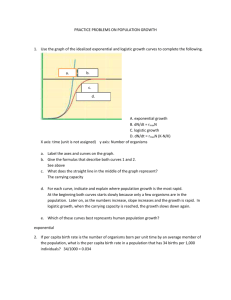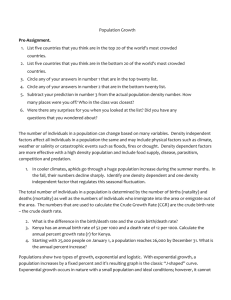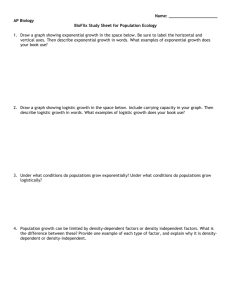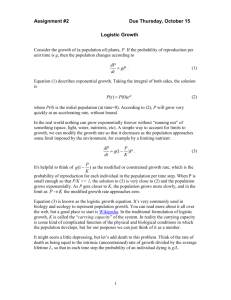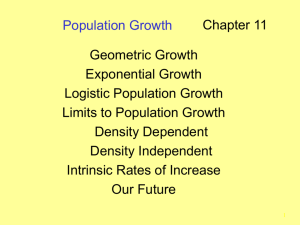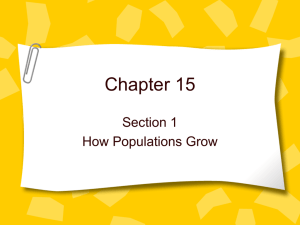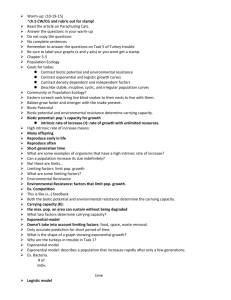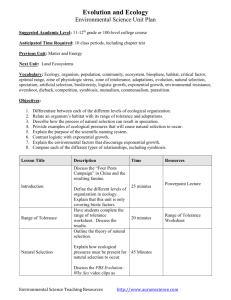53.2-53.3 worksheet
advertisement
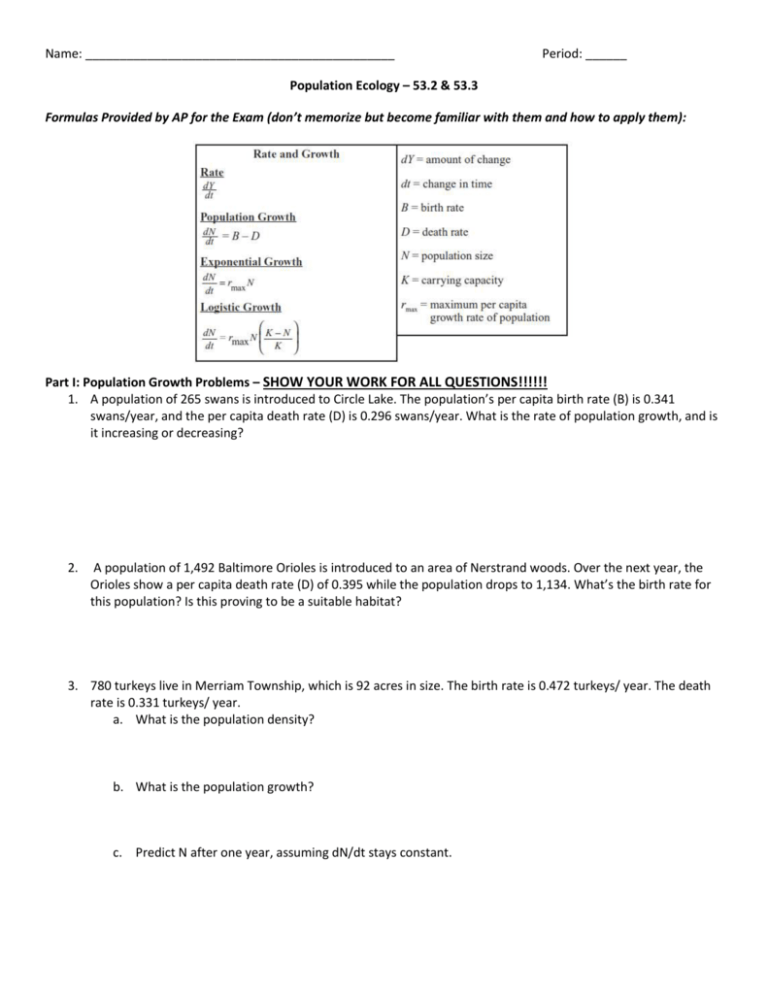
Name: _____________________________________________ Period: ______ Population Ecology – 53.2 & 53.3 Formulas Provided by AP for the Exam (don’t memorize but become familiar with them and how to apply them): Part I: Population Growth Problems – SHOW YOUR WORK FOR ALL QUESTIONS!!!!!! 1. A population of 265 swans is introduced to Circle Lake. The population’s per capita birth rate (B) is 0.341 swans/year, and the per capita death rate (D) is 0.296 swans/year. What is the rate of population growth, and is it increasing or decreasing? 2. A population of 1,492 Baltimore Orioles is introduced to an area of Nerstrand woods. Over the next year, the Orioles show a per capita death rate (D) of 0.395 while the population drops to 1,134. What’s the birth rate for this population? Is this proving to be a suitable habitat? 3. 780 turkeys live in Merriam Township, which is 92 acres in size. The birth rate is 0.472 turkeys/ year. The death rate is 0.331 turkeys/ year. a. What is the population density? b. What is the population growth? c. Predict N after one year, assuming dN/dt stays constant. Part II: Exponential Population Growth Models devised by ecologists describe two kinds of population growth. Exponential growth is described by this 𝑑𝑁 𝑑𝑁 equation: 𝑑𝑡 = 𝑟𝑚𝑎𝑥 N. The rate of growth, 𝑑𝑡 , depends on N, the size of the population, multiplied by rmax, the population’s intrinsic rate of increase. Intrinsic rate of increase, rmax, is calculating the death rate from the birth rate. Exponential growth is unregulated. The bigger the population, the faster it grows. This cannot be sustained for long in real populations, but it is interesting as a theoretical possibility. Populations of fast reproducers like bacteria and insects can grow at near-exponential rates for short periods. 1. Calculate and graph exponential growth of a population of aphids for which rmax = 40% per week. Remember 𝑑𝑁 𝑑𝑁 that 𝑑𝑡 = 𝑟𝑚𝑎𝑥 N. If there are 10 aphids to start, the number of aphids added by the end of the first week ( 𝑑𝑡 ) is equal to rmaxN, or 0.4 x 10, which equals 4. So the total population (N) after one week is 10 + 4 = 14. Round off fractions. SHOW YOUR WORK!!!!!! Week New Aphids Total Aphid Population 1 4 14 2 3 4 5 6 7 8 9 10 2. Graph the aphid population (N) as a function of time (in weeks). Remember that the population size was 10 at time=0. Don’t forget to label the axes of the graph and title it. 3. How could you describe the shape of the graph? 4. Could this kind of growth continue indefinitely? Why or why not? 5. What does it mean for a population to be in exponential growth? Part III: Logistic Growth & Carrying Capacity Exponential growth cannot be sustained for long in any population. A more realistic population model limits growth by incorporating carrying capacity (K), the maximum population size the environment can support. The logistic model fits few real populations perfectly, but is useful for estimating possible growth. According to the logistical growth equation, 𝑑𝑁 = 𝑟𝑚𝑎𝑥 N(K-N)/K, growth levels off as a population size approaches the carrying capacity. With logistic growth, the 𝑑𝑡 intrinsic rate of population growth (r) changes as the population grows and resources become limited. However, the maximal rate of growth (rmax) in the formula is a constant value. 1. In the logistic growth model, the per capita rate of increase approaches zero as the _________________ is reached. 2. What is carrying capacity? 3. In the graph below, explain why the logistic model predicts the sigmoid (S-shaped) growth curve when the population density is plotted over time. Hint: the critical part of this answer concerns why growth slows as N approaches K. 4. Hawks are top carnivores and their population size follows logistic growth if they are reintroduced into an area from which they were previously killed off. Use the following data table and calculations to see how the intrinsic growth rate of the population changes as the population grows. SHOW YOUR WORK!!!!!! Time (years) Population Size N 0 2 1 2 2 4 4 7 6 8 8 9 10 10 12 10 Influence of Carrying Capacity Rate of Intrinsic Population Growth The rmax value is considered to be the point at which the rate of population growth per individual (dN/day)/dN is at the highest value 5. To determine the carrying capacity (K), graph the Time vs. Population Size. 6. Using the graph, determine the point at which the population size becomes stable. In other words, what is carrying capacity (K) for hawks in this ecosystem? Part IV: Review Watch the Crash Course “Population Ecology” video. Write a 7-8 sentence summary below. Be sure to include key terminology from section 53.2-53.3 (ie: exponential vs. logistic growth, carrying capacity).
